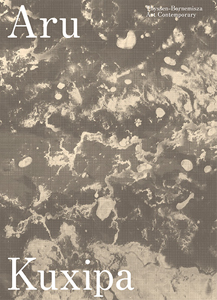This collaborative journey between Brazilian artist Ernesto Neto and members from the Huni Kuin indigenous communities brings to the fore the concept of “ancestral futures” and extends the concerns that have been evident in Neto's oeuvre over the past 20 years: a celebration of the sensuality of being, the unity of bodies and nature, and a longing for spiritual vision.
The exhibition “Aru Kuxipa” was conceived by Brazilian artist Ernesto Neto as a personal tribute to the Huni Kuin. Held at TBA21 – Augarten, the show was a vibrant demonstration of ancestral futures, a term that unpacks potentials for creating a future that is also deeply rooted in cultures of tradition. Through multiple exchanges between members of thirty-two Huni Kuin communities in Brazil, this publication brings together threads from
anthropology, art, and
science that are interwoven, like the movement of a serpent, with essay contributions, oral histories, drawings, and traditional song. Together, they outline the way unique kinships produced within an indigenous cosmo-vision can shape our present moment.
“This is a new story; it is called Aru Kuxipa. It is new, but it is old. Aru Kuxipa to me means our people, the old ones, living together with nature, in balance with our tradition. Aru means secret, sacred. Kuxipa means like a god.” —Txana Bane
With Mila Cataldo, Damian Christinger, James Clifford, Anna Dantes, Fabiano Txana Bane Sales Huni Kuin Kaxinawa, Francesca von Habsburg, Marcelo Piedrafita Iglesias, José Yubē de Lima Kaxinawa, Leopardo Yawa Bane Sales Huni Kuin Kaxinawa, Manoel Dua Busē Vandique Kaxinawa, Ricardo Moebus, Jeremy Narby, Ernesto Neto, Osvaldo Isaka Manduca Mateus Kaxinawa, Tiago Paulino Sales Txana Xiná Bena, Virgulino Ixã Rodrigues Sales Kaxinawa, Pirjo Kristiina Virtanen, Franziska Sophie Wildförster, Daniela Zyman.
Published following the eponymous exhibition at Thyssen-Bornemisza Art Contemporary, Vienna, from June 25 to October 25, 2015.
Through his formal vocabulary, Brazilian artist Ernesto Neto (born 1964, Rio de Janeiro, where he lives and works) engages with the idea of social interaction. Neto has gained acclaim for his large experimental environments that dramatically alter our surroundings, engage all the senses, and invite to interact. The deliberate choice of materials, the simultaneity of internal and external structures, the contrast between the organic and the mechanic, along with sensuality are all phenomena involved in his works. Ernesto Neto's installations draw on the lessonsof minimalist sculpture, New Brazilian Objectivity of the 1960's and 70's, and the anthropomorphic architecture, removing the visitor from the assault and grind of the everyday world and providing an opportunity to slow down and reconnect with essential multisensory experiences. Constantly opening new formal and conceptual developments in his work, Ernesto Neto describes sculpture as a living organism transgressing all limitations.



